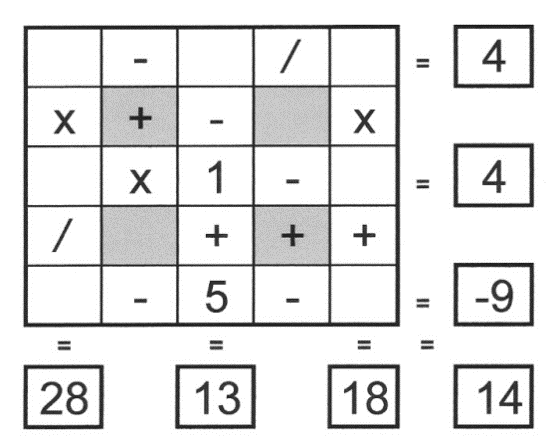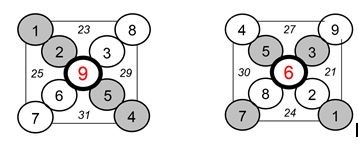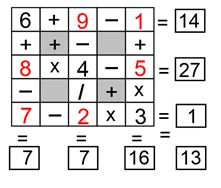Each month, a new set of puzzles will be posted. Come back next month for the solutions and a new set of puzzles, or subscribe to have them sent directly to you.
MIND-Xpander Maths Problem
If N is a whole number and the following limits apply: 2N > 30 and 5N < 100, what values for N are possible?
Petite Circle-Sums Puzzles
The number within the 4 sectors of the outer circle is equal to the sum of the three numbers in its sector. The numbers in the individual circles can only be 1 to 9 and each number can be used only once. One number has been provided to get you started. Find the remaining 4 numbers. Note: There may be more than one solution. 
EQUATE+2 Puzzle
Each row, column & diagonal is an equation and you use the numbers 1 to 9 to complete the equations. Each number can be used only once. ‘Two’ numbers have been provided to get you started. Find the remaining seven numbers that satisfy all the resulting equations. Note – multiplication (x) & division (/) are performed before addition (+) and subtraction (-). 
Feedback
There are more than one way of doing these puzzles and may well be more than one answer. Please let me and others know what alternatives you find by commenting below. We also welcome general comments on the subject and any feedback you'd like to give.
If you have a question that needs a response from me or you would like to contact me privately, please use the contact form.
Get more puzzles!
If you've enjoyed doing the puzzles, consider ordering the books;
- Book One - 150+ of the best puzzles
- Book Two - 200+ with new originals and more of your favourites
Both in a handy pocket sized format. Click here for full details.
Last month's solutions

X-Sums Puzzles

EQUATE+3 Puzzle


Hi Gordon, I was trying to do the equate+2 puzzle. For the column that equals 13 the number on top must be 9. Following pemdas there doesn’t seem to be numbers besides negative numbers that will equal 4 on the top row. Just checking to see if I am looking at this correctly. Thanks
Hi Rodrigo..Excuse the delay in my response…unfortunately, life sometimes gets in the way.
Thank you for your query. In the EQUATE+2 puzzle above, the equations for the top row would read (from left to right): “? – ? / ? = 4” or “? – (? / ?) = 4” and the centre column (from top to bottom) would read: “? – 1 + 5 = 13” or think of it as “? + (-1) + 5 = 13”. PEMDAS (US) as well as BODMAS (UK) are catchy acronyms that establishes the order of basic arithmetic operations but they do not dictate that Addition must be performed before Subtraction as it appears in the order of operation. For A & S ONLY equations, solve them as if you were entering their numbers (from left to right) into a calculator. Then “? – 1 + 5” will provide the correct result “13”. In the puzzle, the same calculator procedure applies to Multiplication (M) & Division (D) ONLY equations. I hope this helps you to enjoy doing the EQUATE puzzles now & in the future.
Hi Gordon, I hope all is well. I see where I made my mistake. Thanks for the reply.